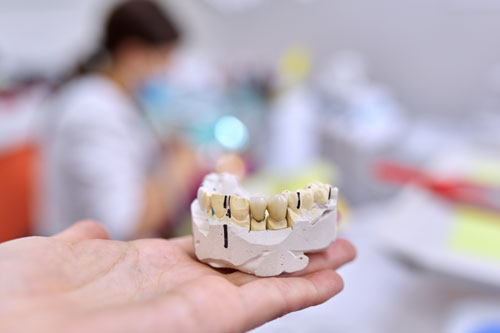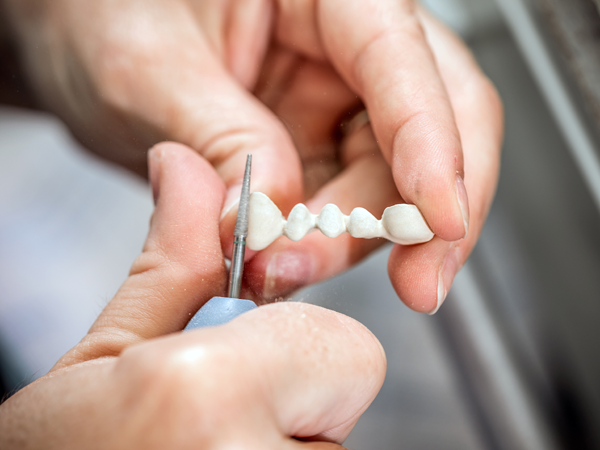What is a dental bridge?
Dental bridges replace missing teeth. Specifically, they can replace one tooth or a row of missing teeth. As the name implies, this appliance literally “bridges the gap” in your smile. Dentists can create custom bridges that match the shade of your natural teeth.

There are different parts that make up a dental bridge:
- Abutments are the structures that support your dental bridge. While the term often refers to natural teeth, it can also refer to tiny connector posts used in dental implant-supported bridges.
- Pontics are the artificial (false) teeth that fill in the gap left behind by missing teeth.
Depending on your situation and the type of bridge you receive, your bridge might consist of one or more abutments and one or more pontics.
Types of dental bridges
Dentists use different types of bridges based on your oral health goals. The main four types of dental bridges include:
- Traditional dental bridge. This is the most common type of dental bridge. It consists of dental crowns (caps) on both ends with pontics (artificial teeth) in between. A dentist bonds the crowns to your natural teeth (abutments) on either side of the gap, and the artificial teeth (pontics) fill in the space between. Dentists use traditional dental bridges when you have healthy natural teeth on both sides of the gap.
- Cantilever dental bridge. A cantilever bridge is similar to a traditional bridge. But there’s only a crown on one end, not both. So, when your dentist bonds the bridge onto your abutment tooth, the artificial tooth (pontic) “hangs over” or extends across the gap. Dentists use cantilever bridges when you only have natural teeth on one side of the gap. Due to their design, cantilever bridges aren’t as strong as traditional bridges.
- Maryland dental bridge. A Maryland bridge (or resin-bonded bridge) uses metal wings instead of crowns to secure your bridge. A dentist bonds the wings to the backs of your neighboring teeth to hold your bridge in place. Dentists typically use Maryland bridges to replace front teeth. These appliances aren’t strong enough to withstand the chewing forces of back teeth.
- Implant-supported bridge. An implant-supported bridge is similar to a traditional bridge, but it rests atop dental implants instead of natural teeth. Dental implants are small threaded posts that replace missing teeth roots. Before attaching a bridge to dental implants, your implants must fully integrate (fuse) with your jawbone. This process takes three to six months on average, but it can take longer depending on your situation. Dentists can use implant-supported bridges when you have three or more missing teeth in a row.

To determine what type of bridge you need, a dentist will consider several factors, including:
- Your age. (Dentists typically don’t place bridges in children.)
- How many teeth you’re missing.
- The size of the gap.
- The condition of your teeth next to the gap.
- Whether you have natural teeth on both sides of the gap.
- The overall health of your teeth and gums
- Your personal preferences.
PROCEDURE DETAILS
What happens during a dental bridge procedure?
It depends on what type of dental bridge you select and plan. Our expert team of doctors at Gurgaon Dental Lounge would explain you the procedure details once you visit us for a consultation.
RISKS / BENEFITS
What are the pros and cons of a dental bridge?
Dental bridges offer many benefits. But there are some drawbacks, too:
Advantages of dental bridges
Dental bridges can:
- Offer a natural-looking solution for tooth loss.
- Restore chewing and speech function (missing teeth can make it difficult to eat or speak properly).
- Prevent neighboring teeth from shifting into the gap left behind by missing teeth.
Disadvantages of dental bridges
Dental bridges also have some drawbacks:
- If decay or trauma results in damage to your abutment teeth, it can weaken your dental bridge.
- If your abutment teeth aren’t strong enough to support your bridge, they can fracture.
- If you don’t properly clean the bridge and underlying gum tissue, plaque and bacteria can cause gum inflammation or cavities
